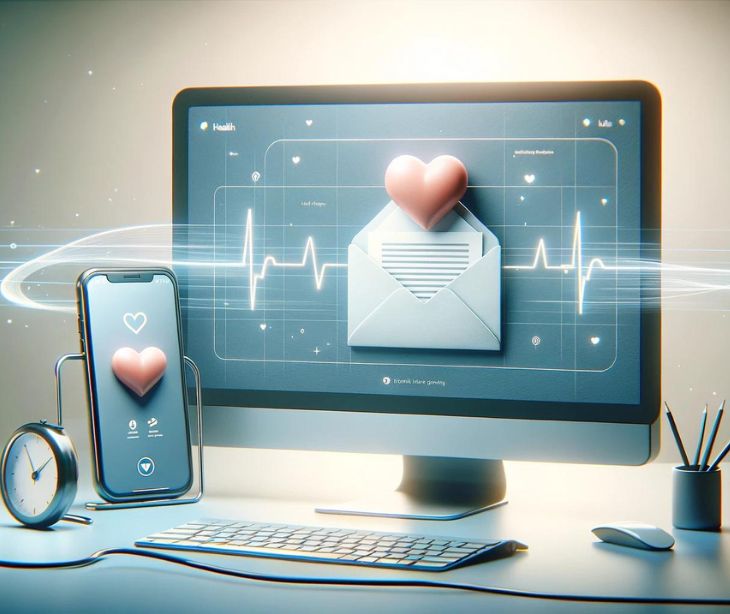7 min read
Choosing between text and email communication in healthcare
Tshedimoso Makhene
March 14, 2024

When it comes to communicating with patients, healthcare organizations can choose between text messages or email. Several factors need careful consideration before making a decision, such as patient preferences, privacy concerns, convenience for both parties involved in communications exchanges, and regulatory compliance issues.
Advantages and disadvantages of using email communication
Advantages
- Efficiency: Email enables rapid communication between healthcare professionals, patients, and other stakeholders. Messages can be sent and received instantly, reducing the time and effort required for information exchange compared to traditional mail or phone calls.
- Convenience: Email allows users to access their accounts from any internet-connected device, including smartphones, tablets, and computers. This accessibility facilitates communication regardless of location or time constraints.
- Document sharing: Email facilitates the sharing of documents, images, and other attachments, making it ideal for sending medical records, test results, treatment plans, and educational materials when used in a HIPAA compliant manner. This capability enhances collaboration and continuity of care among healthcare providers.
- Asynchronous communication: Unlike phone calls or in-person meetings, email enables asynchronous communication, allowing recipients to respond at their convenience. This flexibility accommodates busy schedules and enables individuals to prioritize their tasks effectively.
- Record keeping: Emails serve as a written record of communication, which can be valuable for documentation, reference, and legal purposes. Healthcare providers can archive emails securely within electronic health record (EHR) systems or other document management platforms, ensuring compliance with regulatory requirements.
- Cost-effectiveness: Sending emails typically incurs minimal costs beyond internet connectivity, making it a cost-effective communication method for healthcare organizations.
Disadvantages
- Security risks: Email communication poses security risks, particularly regarding the protection of patient health information (PHI). Without proper encryption and security measures, emails can be vulnerable to interception or unauthorized access, potentially compromising patient privacy and violating regulatory requirements such as HIPAA.
- Spam and phishing: Email accounts are susceptible to spam, phishing, and other malicious activities. Healthcare organizations must implement robust spam filters and educate users about the importance of identifying and avoiding suspicious emails to mitigate these risks.
- Miscommunication: Written communication, including email, can sometimes lead to misinterpretation or misunderstanding due to the lack of tone, body language, and non-verbal cues. Healthcare providers must strive for clarity and precision in their email communications to minimize the risk of miscommunication.
- Overload and inbox management: Healthcare professionals may receive a high volume of emails, leading to inbox overload and difficulty managing incoming messages. Without effective inbox management strategies, important emails may be overlooked or lost amidst the clutter.
- Lack of urgency: While email offers the convenience of asynchronous communication, it may not be suitable for urgent or time-sensitive matters that require immediate attention.
- Technical issues: Email communication relies on internet connectivity and email servers, making it susceptible to technical issues such as server downtime, network outages, and email delivery failures. These technical challenges can disrupt communication and hinder the timely exchange of information.
- Regulatory compliance: Healthcare organizations must adhere to regulatory requirements, such as HIPAA when using email communication to transmit sensitive patient information. Ensuring compliance with data security and privacy regulations adds complexity to email communication in healthcare settings.
Go deeper:
- Rules for HIPAA compliant email communications
- What it means for an email to be HIPAA compliant
- HIPAA Compliant Email: The Definitive Guide
Advantages and disadvantages of text communication
Advantages
- Instantaneous communication: Text messages are delivered almost instantly, allowing healthcare providers to quickly convey important information to patients or colleagues. This immediacy is particularly useful for urgent messages, appointment reminders, or updates on test results.
- High open and response rates: On average, SMS messages have an open rate of approximately 82%, whereas email open rates are roughly 21%. Therefore, patients are more likely to read and respond to text messages promptly, making it an effective tool for delivering time-sensitive information or gathering feedback.
- Concise and clear communication: Due to the character limit inherent in text messages, communication tends to be concise and to the point. This clarity can facilitate better understanding and adherence to medical instructions, treatment plans, or appointment details.
- Accessibility: Text messages can be received on a wide range of mobile devices, including smartphones and basic cellphones. This accessibility ensures that patients who may not have access to email or internet connectivity can still receive important healthcare communications.
- Appointment reminders and follow-ups: Text messages are an efficient way to send appointment reminders and follow-ups, reducing the likelihood of missed appointments and improving overall appointment adherence rates. Automated text reminders can be scheduled in advance, saving time for healthcare staff.
- Improved patient engagement: Text messages can be used to engage patients in their healthcare journey by providing educational content, wellness tips, or reminders for preventive screenings or vaccinations. This proactive approach encourages patients to take an active role in managing their health.
- Privacy and security: Text messaging platforms often offer encryption and other security features to protect sensitive patient information. By adhering to regulatory requirements and best practices, healthcare providers can ensure the confidentiality of text communications.
Disadvantages
- Character limit and lack of detail: The character limit in text messages can restrict the amount of information that can be conveyed, potentially leading to incomplete or insufficient communication. Complex medical information or detailed instructions may be challenging to communicate effectively through text alone.
- Misinterpretation: Written communication, including text messages, can sometimes lead to misinterpretation or misunderstanding due to the absence of tone, body language, and non-verbal cues. Healthcare providers must strive for clarity and precision in their text communications to minimize the risk of miscommunication.
- Spam and phishing: Text messaging is susceptible to spam, phishing, and other malicious activities. Healthcare organizations must implement safeguards to protect patients from unsolicited or fraudulent text messages and educate them about identifying and avoiding potential scams.
- Limited record keeping: Unlike email communication, which can be easily archived and documented, text messages may not be as readily accessible for record-keeping purposes. Healthcare providers must establish protocols for documenting text communications within EHR systems or other documentation platforms.
- Regulatory compliance: Healthcare organizations must ensure compliance with regulatory requirements, such as HIPAA when using text communication to transmit sensitive patient information. Ensuring the security and privacy of text messages adds complexity to their use in healthcare settings.
- Technical limitations: Text messaging relies on cellular networks and may be subject to technical limitations such as network congestion, delivery delays, or message delivery failures. These technical challenges can disrupt communication and hinder the timely exchange of information.
Go deeper:
What to consider when choosing a communication method
Choosing between text and email communication in healthcare involves considerations regarding privacy, security, convenience, and effectiveness. Here are some factors to consider when making this decision:
- Privacy and security: PHI must be protected to comply with regulations such as the Health Insurance Portability and Accountability Act (HIPAA) in the United States. Both email and text messages can potentially be intercepted or accessed by unauthorized parties if proper encryption and security measures are not in place. However, email tends to offer more robust security options, such as encrypted email services, compared to standard text messaging.
- Convenience and accessibility: Text messages are often seen as more immediate and accessible compared to email. Patients may be more likely to engage with text messages promptly, especially if they have notifications enabled on their mobile devices. Email, on the other hand, may be more suitable for less urgent communications or for sending detailed information that patients can review at their convenience.
- Content and context: The type of information being communicated may influence the choice between text and email. Short, concise messages may be better suited for text, while longer messages or those requiring attachments (such as forms or documents) may be more appropriate for email.
- Patient preferences: Some patients may have preferences regarding how they receive communications from their healthcare providers. It's essential to consider patient preferences and offer options when possible.
- Documentation and compliance: Both email and text communications should be properly documented in the patient's medical record to ensure compliance with regulatory requirements. EHR systems often have integrations that allow emails to be securely stored within the patient's record, simplifying documentation processes.
- Cost considerations: Depending on the communication platform used, there may be associated costs. Text messaging services may incur charges per message sent or received, while email communication typically involves minimal to no additional costs beyond standard internet connectivity.
- Technical considerations: Consider the technical capabilities and infrastructure available to both the healthcare provider and the patient. For example, some patients may not have smartphones or reliable internet access, which could limit their ability to receive text messages or access email.
Which is better? Email or text
The best communication method depends on the specific communication needs, preferences of patients, and regulatory requirements of the healthcare organization.
In many cases, a combination of both email and text communication may be the most effective approach, allowing healthcare providers to leverage the strengths of each medium to communicate with patients and colleagues effectively. Additionally, healthcare organizations should prioritize privacy and security considerations and ensure compliance with regulatory requirements, such as HIPAA, regardless of the communication method used.
Paubox solutions
Paubox is a cloud-based, HIPAA compliant email solution provider that helps healthcare organizations send and receive emails. It provides several modules, including an email DLP suite, encrypted email, and HIPAA email API. Recently, Paubox has introduced Paubox Texting - a HIPAA compliant texting API for engaging with patients without the need for them to download third-party applications or use protected portals that require passcodes. This allows healthcare providers to send HIPAA compliant text messages straight to the recipients' mobile devices.
Learn more:
Obtaining consent
Obtaining consent when electronically communicating with patients is crucial for several reasons:
- Respect for patient autonomy: Consent empowers patients to make informed decisions about how their health information is communicated and shared electronically. It respects their autonomy and ensures that their preferences are respected.
- Legal and regulatory compliance: Healthcare organizations must comply with laws and regulations governing patient privacy and data security, such as HIPAA. Obtaining consent demonstrates compliance with these requirements and helps mitigate legal risks.
- Protection of patient privacy: Electronic communication can involve the transmission of sensitive health information, which must be safeguarded to protect patient privacy. Obtaining consent ensures that patients understand the risks and implications of electronic communication and can make informed decisions about their privacy preferences.
- Enhanced trust and transparency: Seeking consent fosters trust and transparency in the patient-provider relationship. It demonstrates respect for patients' rights and preferences and promotes open communication and collaboration.
- Patient safety and quality of care: Clear communication channels are essential for ensuring patient safety and delivering high-quality care. Obtaining consent for electronic communication helps establish effective communication channels while minimizing the risk of miscommunication or misunderstanding.
Go deeper: Patient consent: What you need to know
FAQs
Is it secure to communicate sensitive health information via email or text?
While both email and text communication can be secure with proper encryption and security measures, it's essential to ensure compliance with regulations such as HIPAA to protect patient privacy and confidentiality.
Can I opt out of receiving email or text communications from my healthcare provider?
Yes, patients must have the option to opt out of receiving email or text communications from their healthcare provider if they prefer alternative communication methods. Patients should inform their healthcare provider of their communication preferences and any changes to their contact information.
How can I ensure that my email or text communication with my healthcare provider remains confidential?
Patients should use secure communication methods provided by their healthcare provider, such as encrypted email or secure messaging platforms, to ensure the confidentiality of their communication. Additionally, patients should avoid sharing personal health information in unsecured or public environments.
Subscribe to Paubox Weekly
Every Friday we'll bring you the most important news from Paubox. Our aim is to make you smarter, faster.




